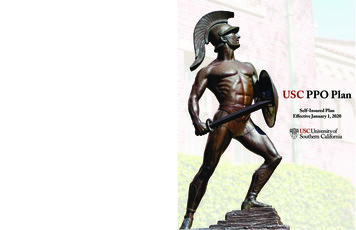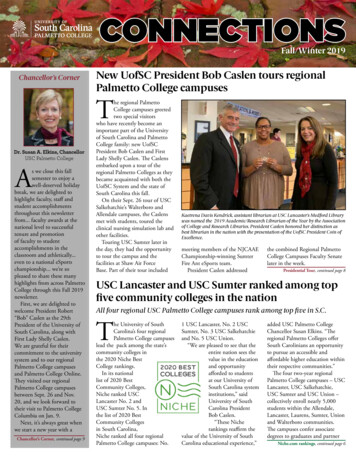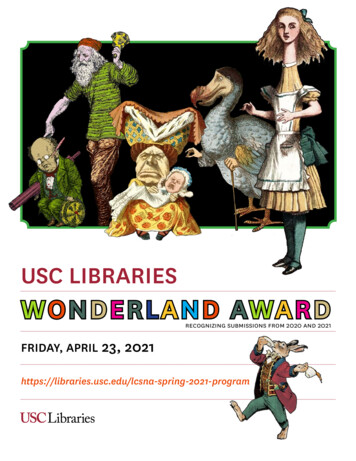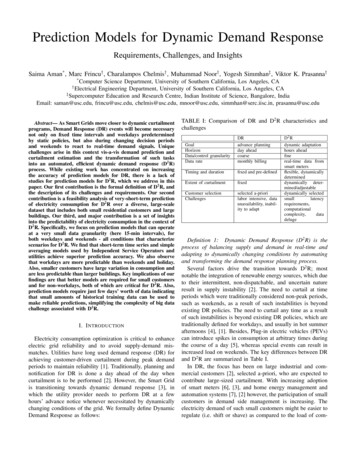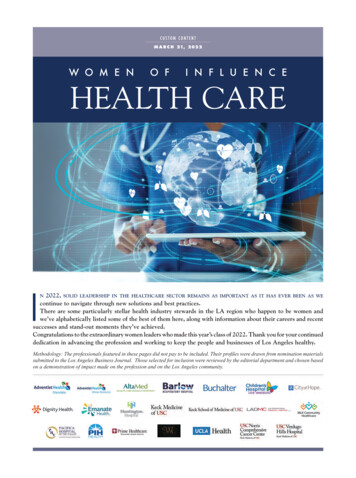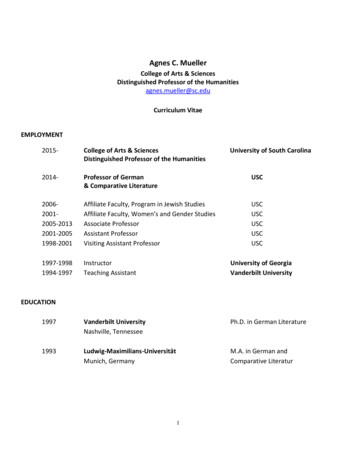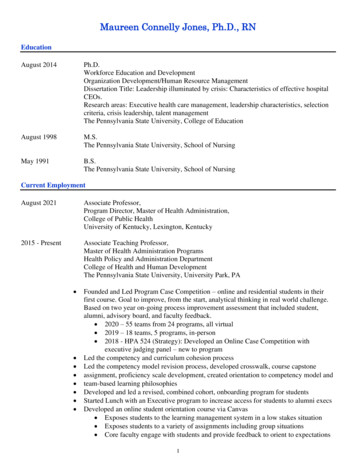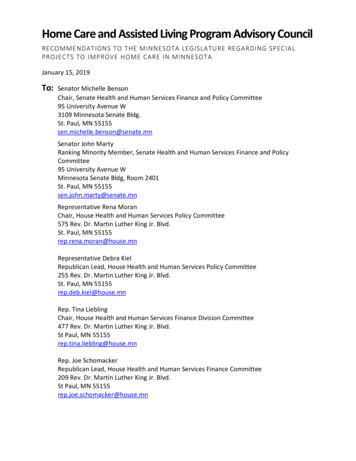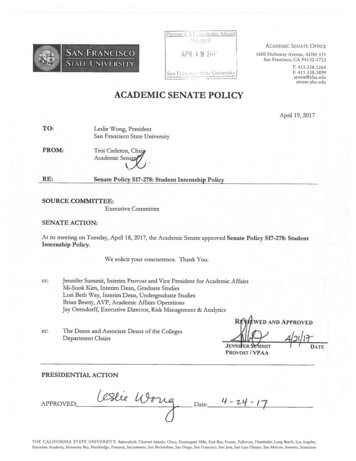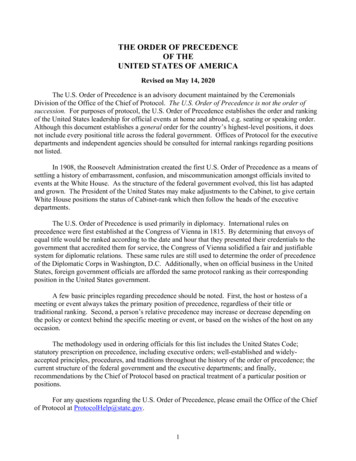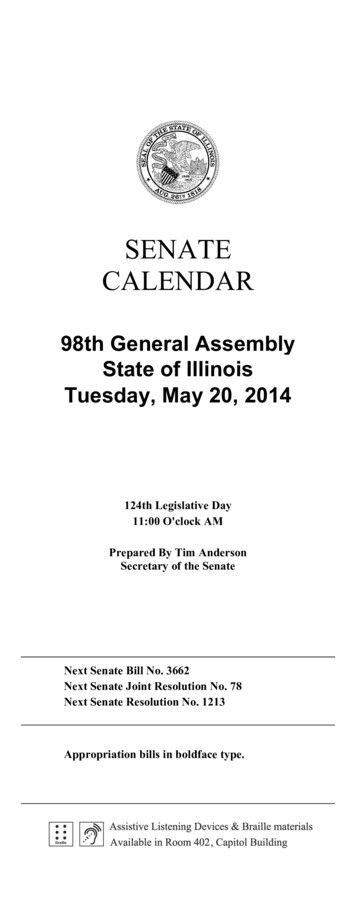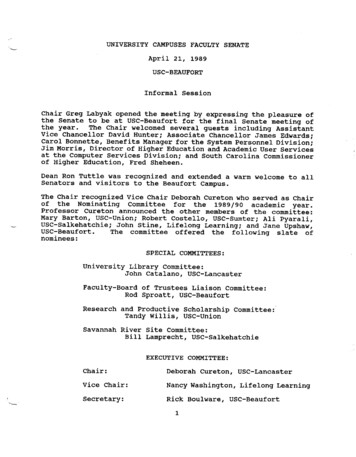
Transcription
UNIVERSITY CAMPUSES FACULTY SENATEApril 21, 1989USC-BEAUFORTInformal SessionChair Greg Labyak opened the meeting by expressing the pleasure ofthe Senate to be at USC-Beaufort for the final Senate meeting ofthe year.The Chair welcomed several guests including AssistantVice Chancellor David Hunter; Associate Chancellor James Edwards;Carol Bonnette, Benefits Manager for the System Personnel Division;Jim Morris, Director of Higher Education and Academic User Servicesat the Computer Services Division; and South Carolina Commissionerof Higher Education, Fred Sheheen.Dean Ron Tuttle was recognized and extended a warm welcome to allSenators and visitors to the Beaufort Campus.The Chair recognized Vice Chair Deborah Cureton who served as Chairof the Nominating Committee for the 1989/90 academic year.Professor Cureton announced the other members of the committee:Mary Barton, USC-Union; Robert Costello, USC-Sumter; Ali Pyarali,USC-Salkehatchie; John Stine, Lifelong Learning; and Jane Upshaw,USC-Beaufort.The committee offered the following slate ofnominees:SPECIAL COMMITTEES:University Library Committee:John Catalano, USC-LancasterFaculty-Board of Trustees Liaison Committee:Rod Sproatt, USC-BeaufortResearch and Productive Scholarship Committee:Tandy Willis, use-unionSavannah River Site Committee:Bill Lamprecht, USC-SalkehatchieEXECUTIVE COMMITTEE:Chair:Deborah Cureton, USC-LancasterVice Chair:Nancy Washington, Lifelong LearningSecretary:Rick Boulware, USC-Beaufort1
Members at Large:Carolyn West, USC-SumterAli Pyarali, USC-SalkehatchieImmediate Past Chair:Greg Labyak, USC-UnionChair Labyak offered some information about the newly constitutedSavannah River Site Committee. This committee was established inresponse to concerns of faculty, primarily from the ColumbiaCampus, regarding the relationship between the University and theSavannah River Plant and whether or not pressure might be broughtto bear on faculty to do certain kinds of research related to theactivities being carried on at the aker,Commissioner of Higher Education, Fred Sheheen. Mr. Sheheen is anative of Camden and a graduate of Duke University with aBachelor's degree in Political Science. He has worked on severalnewspapers including the Charlotte Observer, served in theadministration of Governor Donald Russell and established his ownpublishing and office supply business. Mr. Sheheen has served onthe South Carolina Human Affairs Commission and was a member of theCommission of Higher Education beginning in 1971 before becomingCommissioner in 1987.(Mr. Sheheen s remarks and the question and answer sessionwhich followed are recorded verbatim.)Mr. Sheheen:"Thank you, Greg. Thank you very much. I am really pleasedto have the opportunity to be with you today and to talk to youabout current events and trends in higher education and what'sgoing on. I must say I cannot promise to bring to the USC-BeaufortCampus the prominence and attention that the last visitor fromColumbia brought to the USC-Beaufort Campus because my remarks maynot be that interesting. I also didn't plan my schedule very well.I was at Clemson last evening for a similar presentation at theClemson chapter of the American Association of UniversityProfessors. It was quite an interesting meeting. And then I hadto be in Beaufort today at 9:00 and I have to be back in Clemsontomorrow morning at 1:00 and somehow I have really messed up mytravel schedule.All that did was place the load on the StateAeronautics Commission.It's a pleasure for me to be down in ameeting with the people from the University Campuses. First of allI want to tell you that I will not burden you with any commentsabout supercomputers today. I didn't burden the Clemson audiencelast night with that and we' 11 try to keep our questions andanswers and remarks on those things which should be of primaryinterest to you in your capacity.I expect when we get into thequestion and answer period that you will want to ask me about otherpending developments in higher education which I shan't discuss in2
my major remarks, which I will confine to the planning and theinstitutional effectiveness guidelines largely.And then if weneed to branch out into other areas of concern, we can do that inthe question and answer period.I say that by virtue ofemphasizing to you that it is not my desire to come down here andavoid any questions that might be of interest to you, and orparticular interest to you by virtue of the institutions which youserve.So if I don't mention items that should be mentioned Iexpect them to come up in the question and answer period and we candiscuss them candidly and frankly as we always do, avoiding thetough questions of two-year education in the state, but I willawait your interest in that rather than to introduce the subjectmyself.-"I want to talk a little bit about what the Commission hasdone in the area of planning and in the institutional effectivenessguidelines which apply to all of your institutions.The newplanning process and the institutional effectiveness demands, orthe accountability demands, or the assessment demands, or whateveryou want to call them are grounded in Act 629 which was passed bythe 1988 session of the General Assembly.Now that will be morefamiliarly known to all of you as The Cutting Edge. Act 629 is thelegislation which embodies the concepts in The cutting Edgelegislation which was the reform package for higher education inSouth Carolina. It was in two parts. I'm not going to spend a lotof time of the first part, but briefly to brush by. We asked theGeneral Assembly - and this was a united effort of the institutionsand the Commission on Higher Education - to create a new set offinancial programs for higher education which would enhance thequality of higher educational institutions in this state.Thatincluded, for the first time, a system of merit funded scholars(and those Palmetto Fellows, 47 of them were named last year andapproximately another 509 will be named this year) endowedprofessorships, for the first time, on a matching basis, for theinstitutions of higherlearningin thestate.Endowedinstructorships for the two-year institutions were not implementedthe first year, but I think are designed to be implemented, notthis coming fiscal year, but the next fiscal year, so yearinstitutions will be part of The Cutting Edge package.Thatprovision is in the law. I think it comes on stream next year, sothat the two-year institutions in the state will have state fundswith which to improve specific salary slots and retain theoutstanding faculty people in the two-year system and hopefully toattract, when you have to recruit, really talented people to yourfaculty.So endowed professorships and instructorships are animportant part of the package and the instructorship endowments areparticularly relevant to your institutions. There is a package ofresearch grants that largely benefits the senior universities ofwhich you are a part. The University of South Carolina as a systemreceives the largest distribution of that money, that is the main3
campus in Columbia. I don't know what they do with it after theyget it.We don't follow that.Eventually we will, but theUniversity of South Carolina is the largest recipient of that shareof research money. Last year it was in excess of a million dollarsof unrestricted research money. There are grants for instructionalimprovement in the colleges and universities and that is to permitthe faculties to design programs which will improve curriculum andinstruction at the undergraduate level and we implemented thatprogram last year.There are a number of other miscellaneousprograms that are smaller but contain some financial parameters inThe Cutting Edge."So we asked the General Assembly to give us some money outside ofthe formula to do these unique things for higher education in SouthCarolina, and they did. They gave us five million dollars and weimplemented the programs.There's five million dollars in theHouse version of the bill this year and perhaps to be improved inthe Senate, we don't know, for the implementation and expansion ofthese programs in The Cutting Edge legislation or Act 629.Nowwhat came with that? What came with that is what has come withevery major new public investment program in the last five or sixyears in South Carolina and in the country, and that is a largermeasure of accountability and assessment and effectiveness.Legislative bodies at the state and the national level are nolonger just dumping money into public activities with norequirement for reporting on how well the money is spent and whatresults you're getting. Now I will illustrate that first by usingthe elementary and secondary system. The Education Improvement Actwas passed in the early 1980s in South Carolina. It added a pennyto the sales tax. You all know about that. And it added a numberof new initiatives in the elementary and secondary system to befinanced by that 255 million which is in a trust fund. With thatnew investment in elementary and secondary education came anextraordinary series of oversight and accountability measures.There is a business/education partnership; there is a jointlegislative committee; there is a select committee made up of agroup of select people, public and private, that oversee annuallythe expenditure of that money and the effectiveness of that moneyoutside of the administering agency which is the State Departmentof Education. There are severe testing measures prescribed in theAct for each school - the basic needs assessment program, the CTBSprogram, the exit exam for high school seniors - severe testingprograms to measure how well that money is being used and whatresults we are getting from the elementary and secondary systems.There are provisions in that Act for the state to take over theadministration of school districts where the results are not beingproduced.So in that package, the Education Improvement Act, asin all of the education improvement acts for the elementary andsecondarysystemswhichsweptthecountry,[ thereare)extraordinary accountability and reporting procedures.That seta pattern.4
"Let me move to a different area of public activity.When theGeneral Assembly placed an additional three cents on gasoline taxto improve public roads in the state, a select citizens' committeemade up of public and private people was created outside theHighway Department to oversee the expenditure of that money and toinsure that it was being spent properly. Now when higher educationcame along, not only in South Carolina, but everywhere else, andsaid, 'Give us more money to do a better job,' accountability andeffectiveness came along with it. That was the second part of thepackage.Public higher education is not new to the demand foraccountability and assessment because other areas of publiclyfinanced activity had already begun to experience the samephenomenon before higher educational institutions began to do so.Now, perhaps higher educational institutions were more reluctantbecause outside review of the activities in higher educationalinstitutions - particularly with respect to results and how wellstudents are progressing and allthatoutside review(particularly outside the accreditation process) has really notbeen very prominent in the life of higher educational institutions.So here we come along and we say, 'All of a sudden a lot of peopleare going to be looking over your shoulder. Now the Act provides,and I'm quoting this for your specifically, 'Each institution ofhigher education (and that's all of yours) 'is responsible formaintaining a system to measure institutional effectiveness'(basically how well you I re doing the job) 'in accordance withprovisions, procedures and requirements developed by the Commissionon Higher Education.' Now that last phrase is the one that causesall the problems. Originally that language was that plans had tobe approved by the Commission and there was a lot of debate backand forth at the very highest levels of the higher educationcommunity, with the presidents and all that, and the compromiselanguage that came out was what I read to you:'Maintaining asystem to measure institutional effectiveness in accord withprovisions, procedures and requirements developed by the Commissionon Higher Education.'So the Commission has a strong legal leffectiveness plans. Now, you will recall I'm sure, as members ofthe higher education community, that when we published the firstguidelines for institutional effectiveness in November of 1988there was considerable discomfort among the institutions (that'sa polite way to say that) and we had a major controversy on ourhands about the wisdom of the Commission, the speed with which wehad acted, the lack of faculty input, and several other things thatpeople were all upset about.The Commission voted in earlyDecember to grant a 60-day delay in the implementation and thepublication of those guidelines, to confer with their facultypeople and administrative people and to bring input back to theCommission during the 60-day period at the committee level and atthe Commission level, so that the institutional guidelines forplanning and for institutional effectiveness could be harmonizedwith the institutional views.Now that 60-day period, in myopinion, was extremely helpful and very beneficial.Substantial5
changes were made in the time table for the development of the newstatewide plan.As a matter of fact, a key issue was when thatplan was going to be developed and the publication of that plan hasbeen delayed about nine months and instead of coming out in thespring of 1990, it will be published in January of 1991. So thatdelay in the time table was critical in the eyes of theinstitutions who felt like they couldn't get it all together on thetime table the Commission wanted.A part of that compromise wasthat the Commission itself would move ahead without waiting for thestate plan. The original plan called for us to wait for the stateplan and then draw up state issues and the Commission would addressthose.A part of the compromise was that the Commission itselfwould identity major statewide issues to begin working on and thatwe would have that work done approximately at the time theinstitutional plans came in and it would all be harmonized in thestatewide plan.So we came out with the major change in theplanning prospectus during the 60-day period.And incidentally,for your information, the Commission's Committee on Planning andAssessment adopted the first five major statewide planning issuesday before yesterday and they will be considered by the Commissionat its May meeting. They are quite interesting and we can get intothat a little bit later on."In the institutional effectiveness guidelines, and that s yourprimary concern, the Commission originally promulgated eighteenelements of an institution's operation or function that had to beaddressed in the institutional effectiveness plan.All of themreally don't apply to you, but I'll tell you what they are and youwill know which elements apply to your institutions.1)General education requirements will be surveyed to insurethat there is a breadth of understanding of the studentsin the sciences and the humanities and the socialsciences.2)The quality of the majors will be inquired into to insurethat specific discipline-based programs are in theinstitutions leading to undergraduate degrees and majorsand concentrations.3)The performance of graduates (and some of you may havethese programs) on licensing and certification exams willbe reported - the Law School, the Medical Schools,technical programs, technician programs, any program thatrequires a professional licensure after completion. Theperformance of the graduates will be reported to theCommission as part of the effectiveness planning.4)Report of program changes that have occurred as theresult of external program evaluations.You know thatwe send teams of outside scholars into your institutionsto look at the programs periodically by discipline.6
Those consultants recommend changes to improve programsand if the Commission adopts those reports, then we willbe reviewing changes that have occurred as a result.5)Alumni follow-up studies will be required.6)Entry-level skills necessary for college work must bemeasured and defined and recorded.7)The success of entering students in meeting college anduniversity admissions prerequisites.We already didthat; it will be wrapped into the assessment plan.8)Remedial and developmental programs will have to beaddressed in a planned way and reported to the Commissionand again, in that element, remedial and developmentalprograms for the institutions have to be developedpursuant to rules and procedures and requirementsdeveloped by the Commission on Higher Education. That'sthe second place where that language appears in the Act.So we'll have a strong influence in conferring with theinstitutions on remedial and developmental programs.9)Particularly relevant to you is the achievement ofstudentstransferringfrom two-year tofour-yearinstitutions. The four-year institution is the receivinginstitution and will be required to report the data. Thetwo-year institutions will receive the data and examineit for ways of improving the quality of the people bility thing was a real diplomatic issue in theUniversity system because the University does notconsider students moving from one of its two-yearcampuses to the university campus in Columbia as transferstudents.If they move to Francis Marion or Lander orsome other places they are.10)Analysis of undergraduate retention and attrition we'llbe looking at.11)Minority student faculty access equity we'll be lookingat and all of you know that your institutions areincluded in the new access and an equity program whichthe Commission has adopted beginning July 1, 1989 andthose kinds of activities will be funded in yourins ti tut ions, so we' 11 be looking at the success of thoseactivities.12)Blessedly for all of you perhaps,the academicperformance of student athletes is not relevant - that'sstudent athletes on intercollegiate scholarships.Wewill be looking at athletes who have grants-in-aid to7
play on NCAA teams or in other intercollegiate sports asto the academic performance of them and that will bereported to the Commission on a regular annual basis.13)There will be an inquiry into student development. Theremust be assessment procedures for student developmenton each campus - that's personal development.14)Some more technical items:the assessment of libraryusage in collection development,15)The assessment of administrative and financial processesin performance.That's going to tell us, we hope, howwell the chancellors and the deans and the presidents areperforming because we felt like we needed some measureof the administrative performance if we were going tobear down on the faculty and the students.We reinterested to see what we get out of that number fifteen.16)Assessment of facilities - that will be a very technicalthing.Ron [Tuttle) gave me an assessment of hisfacilities this morning because I was taking a tour ofall his projects this morning because he has a lot ofneeds down here.We' 11 be doing that in more of ascientific fashion than by walking around and looking atthe construction underway.But anyway, the assessmentof facilities is a part of it.17)Assessment of public service and18)Assessment of research for the institutions that haveresearch as an important part of their mission."Now I like to think that the institutions of higher learning willwelcome and inquiry into these various aspects of it and I believethat, despite a storm which incurred a lot a debate and a lot ofdiscussion, that the institutions of higher learning, as indeed theCommission itself, welcome an opportunity to look at how well weare doing our jobs and to use that information to improve theaspects of our institutions and to justify needs to the GeneralAssembly, financial and other needs. If we look at assessment andeffectiveness evaluation as a methodology for self-improvement andas a methodology for justifying needs to the General Assembly andthe tax-paying public in South Carolina, then I think we have avery constructive enterprise and that's the way the Commission onHigher Education looks at it."I should add as a footnote that on the way is a plan for measuresto look at the effectiveness of the Commission itself. We have hadduring my history only two real reviews of the effectiveness of theCommission on Higher Education. One came in 1986 when an outsideconsulting firm came in and looked at the Commission's operation.8
It was a part of the AVA study and made recommendations,substantial in nature, for the improvement of the Commission'soperations, some legislative, and most of those recommendationshave been implemented. When I became Commissioner, after about sixmonths, we had another evaluation of the Commission made by theHuman Resources and Development Division of the state governmentand that told us some things we were doing right and some thingswe were doing wrong, but the evaluation of the Commission willbecome an orderly part of the effectiveness program for highereducation in South Carolina and those guidelines are being drawnat the present moment. For my part I think it's constructive. Ilike it and I welcome people looking at what we're doing and givingus an evaluation of it. I just think if you're trying to do agood job you should welcome that kind of inquiry and certainly Iwelcome it for the Commission."The last thing I want to say is that the institutions of higherlearning themselves have come together in the State HigherEducational Assessment Network and I do not know how many of theseinstitutions are part of that, John [Duffy], do you?[Reply from Dr. Duffy, "All of them.11 ]"All of you are a part of the State Higher Education AssessmentNetwork.Now that had its genesis in an extraordinaryappropriation to Winthrop College when Martha Kine Piper waspresident, as a pilot project in assessment.Winthrop took thatmoney (we gave them 125,000) and got it matched by the Fund forthe Improvement of Post-Secondary Education, a FIPSE grant, andthey had about a quarter of a million dollars to establish primarywork in assessment. Winthrop has taken that and put together theState Higher Education Assessment Network and I went to the firstmeeting in Rock Hill for much of a day.It appeared to me thatwhat was happening is what should happen in South Carolina, andthat is that the academic people and the administrators and thepublic higher education system in this state have taken assessmentand accountability and institutional effectiveness upon themselvesas an academic enterprise and an enterprise of the institutions.I think the best thing that could happen to the Commission onHigher Education is to have the State Higher Education AssessmentNetwork in being to insure that accountability and effectivenessare not methodologies that are imposed on you from the outside, butare assumed by the institutions of higher learning willingly. TheState Higher Education Assessment Network can serve as an importantsource of information and advice and counsel to the institutionsthemselves and to the Commission on Higher Education which has asubstantive legal responsibility in the area of institutionaleffectiveness and evaluation and accountability."Finally, before I open the floor for questions, and I certainlydo not want to impose on your time, I would like to say this aboutthe picture in higher education in the state. You know, from time9
to time we have debates, and we have arguments, and we have issues,and sometimes they are between and among institutions and I won'tlist them all that are on the current agenda, but there's alwaysone or more issues between and among institutions. And sometimesthey are issues between and among institutions and the Commissionon Higher Education. And sometimes the debate gets loud and makesa lot of noise and people get discouraged and they say, 'Oh Lord,what's happening to us?' But the truth of the matter is you don'tmake much progress in any kind of prize without a vigorousexploration of the alternatives, the policy alternatives and theideas which people have.And ultimately, after we have thatthorough exploration of issues which I hope is always in a civilfashion, we define a course of action for the state of SouthCarolina and a course of action for higher education which we allhope is for the benefit of the people in the state.And I thinkas long as we remember that our ultimate destiny is to serve thepeople of the state, that the lively debate and the stimulatinginquiry should not discourage us.I enter into all of thesepropositions with that understanding, that we are all not going toagree all the time on all the things that we do, but out of thatlively and spirited debate - particularly in the higher educationalcommunity where you have really informed, inquiring minds - thatout of all that debate and discussion will come what is best forthe state of South Carolina.And I am sure, as I stand here inthis room (and I never doubt in any of the deliberations in whichI am involved) that all of us aspire to that goal and the debateis really how are we going to get there.I can assure you thatthat is my posture and the Commission's posture. I thank you, Mr.Chairman. I'll be pleased to answer questions.Chair Labyak opened theProfessor Jerry Dockery.floorforquestionsandrecognizedProfessor Dockery (Lifelong Learning):"First of all I'd like tostate that faculty look forward to assessment, but what theCommission might perceive as foot-dragging on the part of theinstitution is in fact not foot-dragging at all, but realdifferences among faculty members on how we ought to proceed withcertain things. After we get past that obstacle, we also have toget past another obstacle and that is that the administrationalways see things differently than the faculty sees them and therehas to be more negotiation there. And a lot of times some of thethings that I see us as being accused of dragging our feet on, weare not dragging our feet; we're out there slugging each other andit just takes a long time for the fight to end."Mr.Sheheen:"One of the reasons that the institutionaleffectiveness guidelines will not be fully implemented for threeyears is in recognition of the facts that you are talking about.It's going to take time for people to get the processes and theirthinking in order. Even though the particular topics are specifiedin the Commission's outline or guidelines, the methodologies are10
largely left up to the institutions except in one or two instances.You all have to thrash all that out inside the institutions; it waspurposely left that way so that the institutions could addresstheir own unique roles and missions.so, even though theguidelines say address this topical area, the methodologies arelargely left up to the institutions except in one or two instanceswhere they are pretty prescriptive. The other thing I want to sayis, that of the 18 elements, 12 or 13 of them are drawn from theSACS criteria, the Southern Association criteria. And then peoplesay, 'Why are you doing it, if SACS is already doing it? Well,first of all (and I've had extensive discussions with the executivedirector of the Southern Association Commission on Colleges) SACSonly requires you to do the thing every ten years because that'swhen your accreditation process is up. That is not sufficient forSouth Carolina; we think we need annual evaluations and thelegislation calls for that. Secondly, SACS accreditation reportsare confidential.They are not made public.I had a longdiscussion with them about that, and they cannot be made publicwithout the explicit permission of the institution.Act 629requires the results of the institutional effectiveness plans inSouth Carolina to be made public and submitted to the GeneralAssembly and to the taxpayers of the state. So there are importantdifferences.But we have used elements of the SACS criteria sothat, as you do the annual evaluation in these elements, presumablyit will be much easier for you to address the ten-year cycle atSACS. IIProfessor Dockery: "You mentioned two things: evaluating deans,chancellors and presidents, and also evaluating the Commission andI would like to just put in a plug for including faculty in thatevaluation."Mr. Sheheen:"We figured other elements picked up facultyperformance and the evaluation of individual faculty members willbe "Professor Dockery:"No, I mean using faculty to evaluate deans."Mr. Sheheen: "Oh, oh, oh, using faculty . Well, now that isinteresting! But we left that methodology up to the institutionsand I hope that they will be enlightened enough to include thefaculty in that evaluation, John [Duffy]?"Dr. Duffy:"I'm sure they will.I have one comment.I reallywould like your reaction to it. Listening to all this, there's onething I don't think the Commission is addressing, Fred, and I don'tthing SACS is addressing, and that's the non-traditional [student].We have about five thousand students that are taught by televisionby the University of South Carolina and another several thousandare taught by GRS. The second part, still non-traditional: mostof the students that these people deal with and many that we dealwith in Columbia are older students. They are also in school for11
a short time, taking just one or two courses.I think that weshould be able to assess them, but I'm not too sure that we canassess, under the plan that you put forth, that kind of nontraditional student. I would like the Commission to pay attentionto this."Mr. Sheheen:"Let me transfer that to the two-year institutionswhich
USC-BEAUFORT Informal Session Chair Greg Labyak opened the meeting by expressing the pleasure of the Senate to be at USC-Beaufort for the final Senate meeting of the year. The Chair welcomed several guests including Assistant Vice Chancellor David Hunter; Associate Chancellor James Edwards; Carol Bonnette, Benefits Manager for the System .
